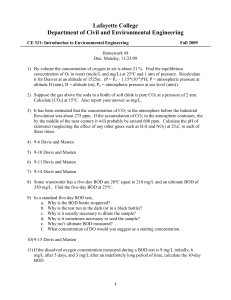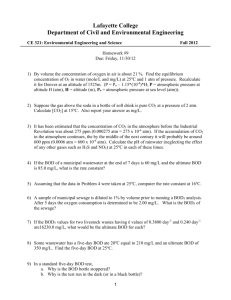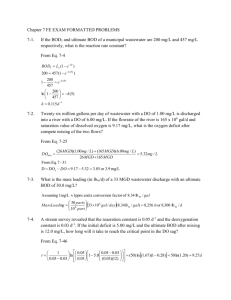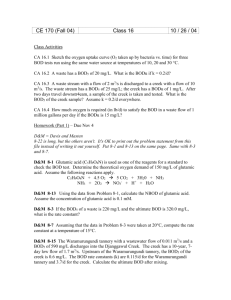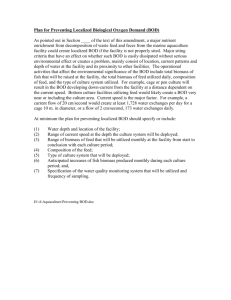DEPARTMENT OF CIVIL ENGINEERING
advertisement
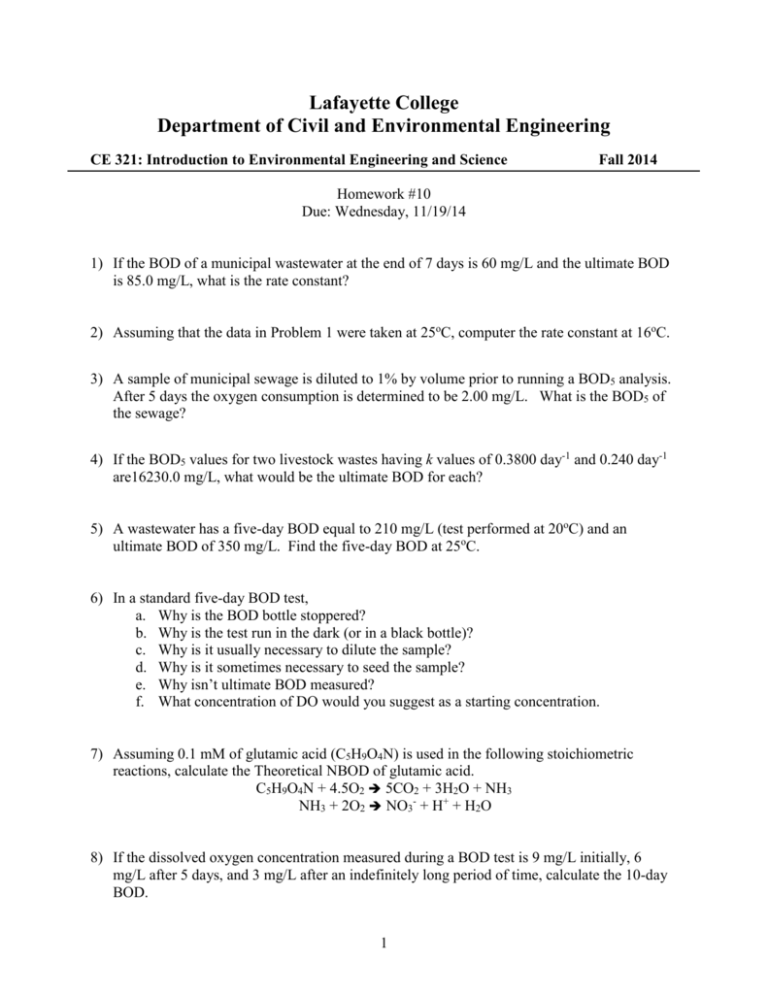
Lafayette College Department of Civil and Environmental Engineering CE 321: Introduction to Environmental Engineering and Science Fall 2014 Homework #10 Due: Wednesday, 11/19/14 1) If the BOD of a municipal wastewater at the end of 7 days is 60 mg/L and the ultimate BOD is 85.0 mg/L, what is the rate constant? 2) Assuming that the data in Problem 1 were taken at 25oC, computer the rate constant at 16oC. 3) A sample of municipal sewage is diluted to 1% by volume prior to running a BOD5 analysis. After 5 days the oxygen consumption is determined to be 2.00 mg/L. What is the BOD5 of the sewage? 4) If the BOD5 values for two livestock wastes having k values of 0.3800 day-1 and 0.240 day-1 are16230.0 mg/L, what would be the ultimate BOD for each? 5) A wastewater has a five-day BOD equal to 210 mg/L (test performed at 20oC) and an ultimate BOD of 350 mg/L. Find the five-day BOD at 25oC. 6) In a standard five-day BOD test, a. Why is the BOD bottle stoppered? b. Why is the test run in the dark (or in a black bottle)? c. Why is it usually necessary to dilute the sample? d. Why is it sometimes necessary to seed the sample? e. Why isn’t ultimate BOD measured? f. What concentration of DO would you suggest as a starting concentration. 7) Assuming 0.1 mM of glutamic acid (C5H9O4N) is used in the following stoichiometric reactions, calculate the Theoretical NBOD of glutamic acid. C5H9O4N + 4.5O2 5CO2 + 3H2O + NH3 NH3 + 2O2 NO3- + H+ + H2O 8) If the dissolved oxygen concentration measured during a BOD test is 9 mg/L initially, 6 mg/L after 5 days, and 3 mg/L after an indefinitely long period of time, calculate the 10-day BOD. 1 9) The following figure shows a plot of BOD remaining versus time for a sample of the effluent taken from a wastewater treatment plant. a. What is the ultimate BOD (Lo)? b. What is the five-day BOD? c. What is Lt for 7 days? 10) If the BOD5 for some wastewater if 200 mg/L and the ultimate BOD is 300 mg/L, find the reaction rate constant k (base e) and K (base 10). 11) Suppose a wastewater has a BOD5 equal to 180 mg/L and a reaction rate (k) equal to 0.22/day. a. Find the ultimate carbonaceous oxygen demand (CBOD). b. Find the remaining BOD after five days have elapsed. 12) Glutamic acid (C5H9O4N) is used as one of the regent for a standard to check the BOD test. Determine the theoretical oxygen demand of 150 mg/L of glutamic acid. Assuming the following reactions: C5H9O4N + 4.5O2 5CO2 + 3H2O + NH3 NH3 + 2O2 NO3- + H+ + H2O 2 13) 10.0 ml sample of wastewater with enough water to fill a 300 ml bottle has an initial DO of 9.0 mg/L. To help assure an accurate test, it is desirable to have at least a 2.0 mg/L drop in DO during the five day run, and the final DO should be at least 2 mg/L. For what range of BOD5 would this dilution produce the desired results. Assume this test to be a five-day, unseeded BOD test. 14) A water sample is diluted by a factor of 10 using seeded dilution water. Dissolved oxygen concentration is measured at 1-d intervals, and the results are listed below. Using these data, determine the BOD as a function of time, i.e., calculate the BOD for each day. Time, d 0 1 2 3 4 5 6 7 Diluted Sample Dissolved Oxygen, g/m3 8.55 4.35 4.05 3.35 2.75 2.40 2.10 1.85 3 Seeded Blank Dissolved Oxygen, g/m3 8.75 8.70 8.66 8.61 8.57 8.53 8.49 8.46

